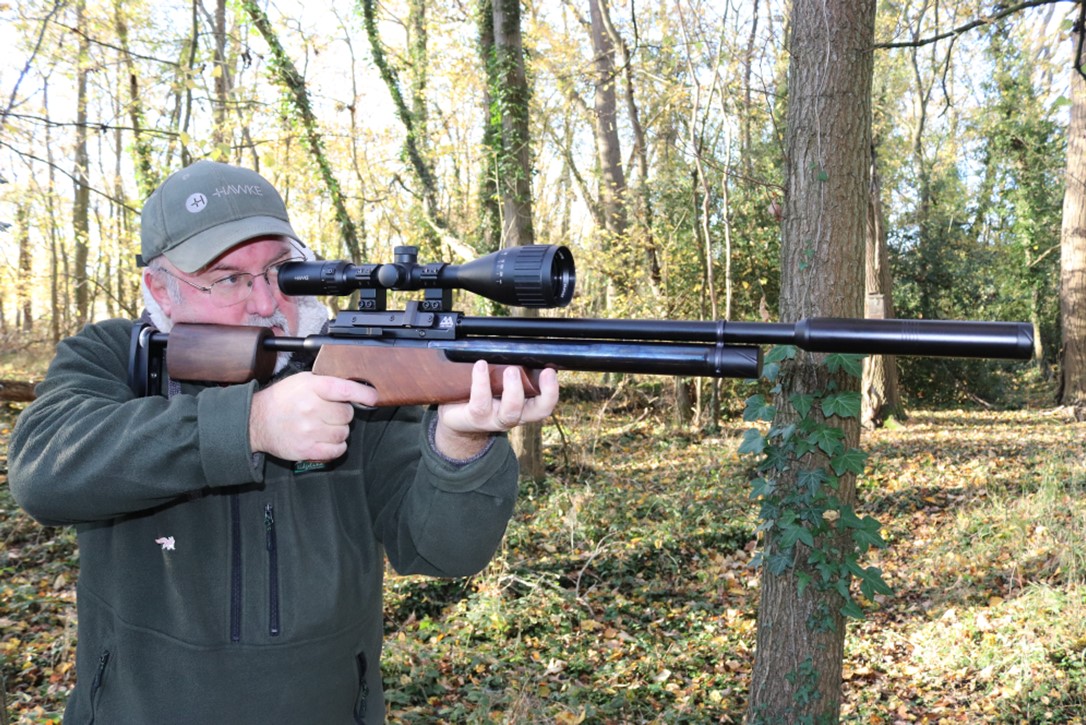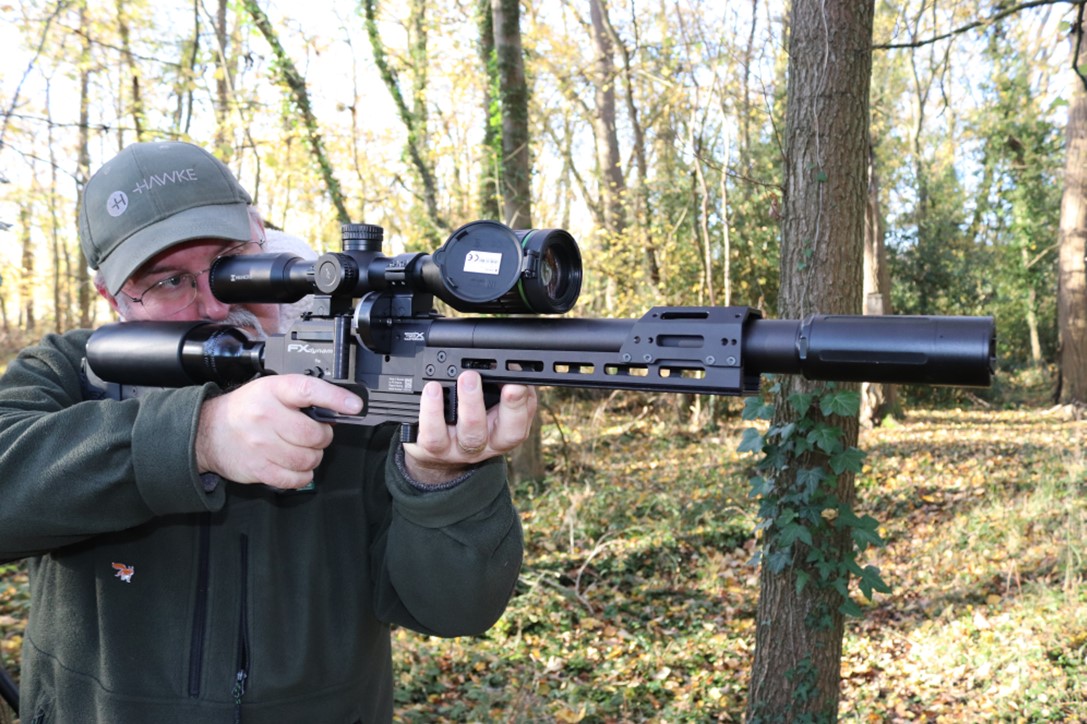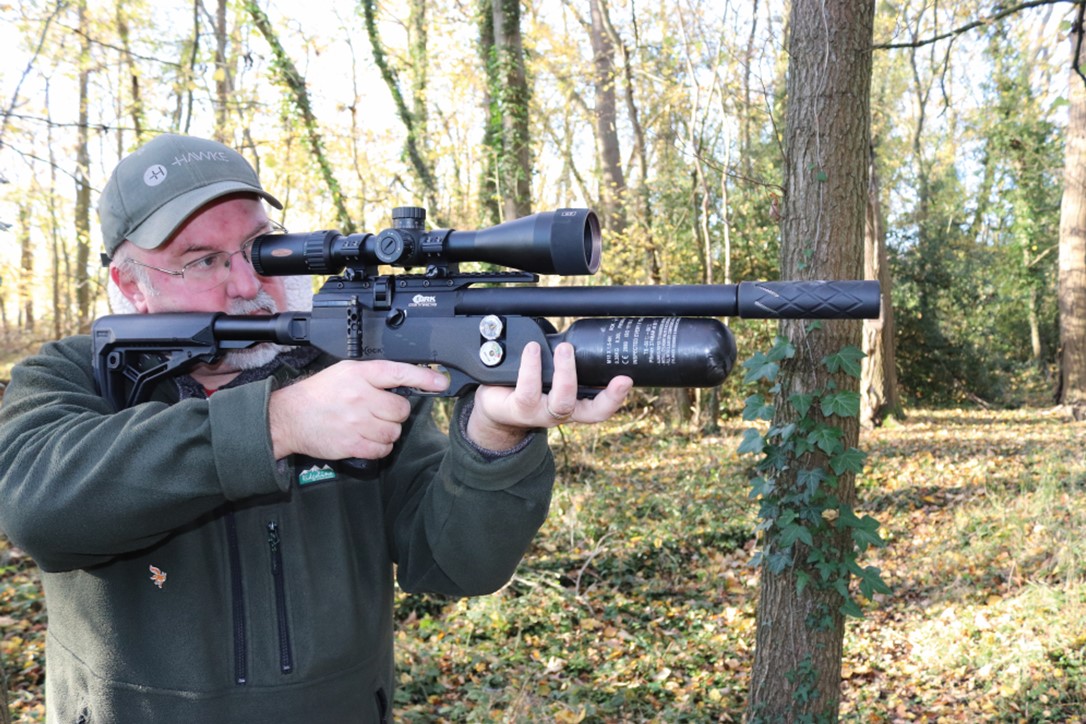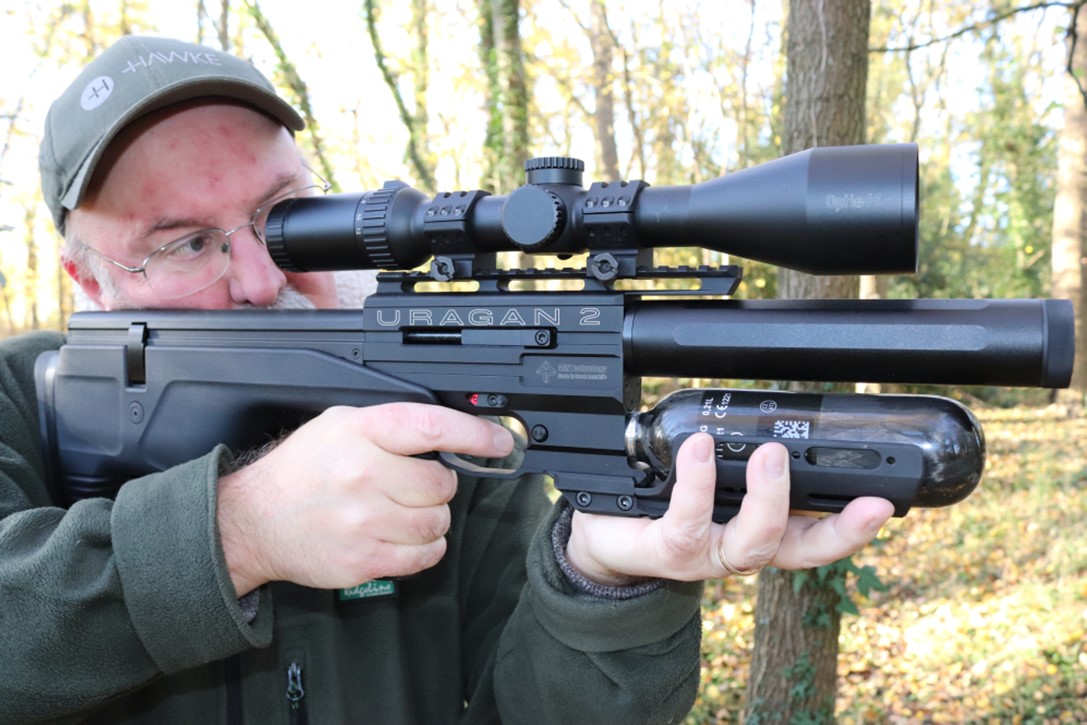I knew a bloke who used to control the feral pigeons on a stately home. It was a nice gig – beautiful surroundings, plenty of ferals to keep him busy – it even had a teashop where cuppas and buns were free. The only problem was that the house was open to the public and as a result, although he was able to shoot in areas hidden from prying and potentially offended eyes, walking about with a rifle over his shoulder was problematic. He got around the problem by using a takedown rifle – an FX Verminator if memory serves. To the non-airgun enthusiast’s eye, he looked like a maintenance man wandering about with a drill in its case.
Takedowns have always been something of a niche, but just recently there seems to have been something of a renaissance in rifles that break down into components, or fold in half or are simply tiny. The ability to be able to carry an air rifle less conspicuously is a potentially tricky area, and needless to say, all the usual rules – both legal and those based in common sense – apply, but there’s no doubt such rifles are easier to transport and store, and generally speaking they are lighter too. Are they any good, though? Unnecessary movement in a stock is not usually a good thing, and yet any rifle that you have to put together yourself, or that folds in half is, by design, going to move more than a traditional rifle, and seeing as gun fit is the basis for accurate shooting, do compact rifles fit properly?
We’ve gathered together four of the best folding, takedown and super-compact rifles to see for ourselves.

Air Arms S510R TDR
£1,289
air-arms.co.uk
Based on the S510, the Air Arms takedown (TDR) range offers a choice of a regulated or non-regulated 12 ft.lbs. rifle with a walnut stock – the soft-touch, black handle has been discontinued – priced at £1,139 and £1,289 respectively. The high power S510 XS TDR delivers 20 ft.lbs. in .177, and 30 ft.lbs. in .22, and costs a little more.
The S510 TDR qualifies as a takedown rifle by virtue of its removable butt section – a single bar, that carries a wooden cheekpiece and height-adjustable shoulder pad. Aligning three prongs on the bar and a spigot on the back of the action, the two are pulled together by tightening a silver wheel forward of the shoulder pad.
Once tight, the length of pull is around 375mm, and you’d have to look very hard to detect any movement. The pad, along with the cheekpiece that can stow two spare magazines, gives excellent ambidextrous shoulder fit and eye alignment for a scope mounted on the 156mm dovetail.
Like the full rifle on which it is based, the TDR boasts a super-slick sidelever located on the right of the block, and Air Arms’ trusted 10-shot magazine that slots into the breech against a stop from the left. The fore end also features a short accessory rail.
Accessed via a pistol grip that has stippling as well as grooves to accommodate your thumb and trigger finger, the adjustable two-stage trigger contains a safety button within the blade.
Overall, the S510 TDR models measure 1,030mm of which 395mm is the shrouded Lothar Walther barrel, and 95mm is the supplied silencer. In addition to making the rifle easy to pack away in its supplied hard case, the TDR’s design delivers a weight saving of nearly half a kilo compared to the traditional rifle.
Filled to its recommended 200 bar – a process achieved by removing a screw-on cap at the front of the air cylinder and locating the slot on the fill attachment over a bar on the valve, then rotating 90 degrees – our .177 regulated review rifle delivered just over 70 shots.
A 10-shot string in the middle of the fill range showed a variation of just nine feet per second (fps) for an average of 788fps or 11.71 ft.lbs.. Loaded up with Air Arms Diabolo Field pellets, the 10mm centre-to-centre,10-shot group at 30m opened only slightly to 14 mm at 40 metres.

FX Dynamic Compact Takedown Black VP
£1,410.99
sportsmanguncentre.co.uk
When FX released the Panthera, few would have guessed how many versions and models it would spawn. The latest, the Dynamic takedown, itself comprises several variants. The one we have on test is the 300mm barrel Compact model.
Carrying the VP designation means it has a 400cc alloy bottle rather than the more expensive, carbon-wrapped alternative. As a result, it’s a little heavier. Even so, it only tips the scales at a smidge over 3kgs.
The bottle forms the butt and unscrews with barely a whisper of escaping air. A synthetic boot can be moved to adjust length of pull and a carbon rod extends the height-adjustable shoulder pad further.
Eye alignment for a scope mounted on the 20 MOA Picatinny rail benefits from higher mounts, but cheek weld is fine, and the rubberised pistol grip sets you up to attack the two-stage, fully adjustable post and shoe-style trigger.
Twelve ft.lbs. models come with FX’s 23 point macro power adjuster, but the micro-adjuster although still present, will only work on high-power models. Located as standard on the right side, along with the safety switch, the sidelever operates with a ‘clunk click’ feel to it. Lefties will be pleased to know it can be swapped to the other side. Operating it drives pellets through a 22-shot .177 or 18-shot .22 magazine.
As with all Panthera-based variants, the Dynamic’s twin gauges for fill and regulator pressures are angled toward the shooter. The rifle takes a 250-bar maximum fill which is achieved by removing a cap from the valve on the underside and attaching an airline with a foster fit adaptor.
The Dynamic’s chunky shroud is finished with a ½ inch UNF thread for a silencer and incorporates a plenum that surrounds the barrel. This neat engineering solution provides additional support for the barrel which FX says improves harmonics and accuracy.
An aluminium cage that has an Arca rail for accessory attachments engulfs the shrouded Smooth Twist barrel and accentuates the Dynamic’s tactical styling, whilst providing a comfortable grip for your leading hand.
The .22 calibre test rifle delivered close to 200 shots from a 250-bar fill, pouring most of them through one-hole groups at 30m and 40m, the best of which were 11mm and 15mm centre-to-centre respectively with JSB Hades pellets. Variance over a 10-shot string in the middle of the fill range was 14fps with an average velocity of 555fps or 10.89 ft.lbs..

BRK Pathfinder
£1,220
brocock.co.uk
The last couple of years have seen something of a resurgence in Brocock, defined by the company’s gradual re-imaging as BRK; the Ghost has been a smash hit, the Ranger XR found a strong following too, and latterly the Pathfinder XR has kept up the momentum.
The rifle’s folding, telescopic stock makes it highly portable, especially if you splash out another £130 for the backpack option that includes a 110mm 0dB silencer. Folded and without a silencer, it’s only 453mm long. With the stock in position, the Pathfinder is still only 735mm fully extended and 660mm fully retracted. Unscoped, weight is 2.9kgs.
To fold or release the stock you have to push the butt section up against a sprung hinge. There’s a little movement when fully extended but nothing that will impact performance. The telescopic feature results in a length of pull that varies in six lockable stages between 355mm and 430mm.
A slick short-throw sidelever operates a gated self-indexing magazine offering 11 shots in .22 and 13 in .177. The black polymer stock is covered in miniscule pimples and the pistol grip, which can be swapped for an after-market alternative, has more pronounced pimples on the back and moulded stippling on the front.
Forward of the breech is a low/medium/high power adjuster that alters output by roughly 20 per cent in each setting. The two gauges show pressure in the Huma Air regulator and the 300cc air bottle, which is filled by attaching an airline directly to the valve located beneath a magnetised cap on the underside. A 250-bar fill will deliver 200+ shots.
The two-stage adjustable post and shoe match-style trigger delivers excellent feel, communicating the transition between the two-stages. Located within the trigger guard, the safety catch is live when pushed to the left.
The full-length shroud does a commendable job of reducing muzzle report, but most shooters, especially those who hunt or carry out pest control, will want to fit a silencer to the ½ inch UNF thread.
On the shooting bench, a 10-shot string in the middle of the fill range showed a variance of 11fps on the .22 review rifle with an average velocity of 570fps (11.47ft.lbs.) with 15.89 grain Daystate Sovereign pellets. Grouping was superb with 8mm centre-to-centre groups at 30m and 14mm at 40m.

AGT Vixen Short
£1,900
edgarbrothers.com
There’s no fancy folding stock and nothing unscrews. Instead, at just 645mm, the Uragan 2 Compact is simply a tiny rifle that fits easily in a backpack where you’d barely notice its 3kgs. Sharing some features with the Vulcan 3, stock finishes include; walnut, carbon, the synthetic version we have on test, and a couple of laminates, with prices ranging from £1,900 to £2,300.
A height adjustable shoulder pad means gun fit is good, even if you have to rest your cheek on a hard polymer top rail. So, too, is eye alignment thanks to a 20 MOA sloped 200mm Picatinny rail.
Despite is Lilliputian dimensions, the bullpup design hides a 400mm cold-hammer forged CZ barrel that is finished with a 195mm shroud-cum-silencer to which another silencer can be fitted. The design also means the 12-shot .22/15-shot .177 magazine is loaded from the left into the breech a couple of inches forward of the butt. You get two magazines along with a nifty bench mat on which to lay your rifle.
As with other AGT rifles, the biathlon-style sidelever is installed on the left as standard, but can be swapped over in a matter of minutes. It operates smoothly and has a robust mechanical feel.
The Uragan 2 Compact’s trigger is fully adjustable, and the blade clearly translates the transition between the two stages. Immediately above it, the safety catch can be operated from either side. Slid forward, the rifle is live although there is little in the way of a click to communicate the two positions.
Filling the Uragan 2 is achieved by inserting the probe into a port forward of the trigger, on the left behind the manometer. AGT supplies the probe with a whip that will snap directly onto a dive bottle. Alternatively, you can screw the probe into a Foster Quick-Connect adaptor and attach it to an airline.
A 300-bar maximum fill is possible, although 250-bar is more practicable unless you have a compressor. Thanks to the regulated action, shot count from the 210cc carbon-wrapped bottle, which is cradled in a synthetic shoe, was around 100 .22 shots from a 250-bar fill.
Consistency was superb, with a spread of just 5fps over 10 shots that averaged 578fps or 11.79 ft.lbs. Using JSB Hades, accuracy from our .22 test rifle was equally impressive; 30m 10-shot groups measured just 9mm centre-to-centre, spreading to 12mm at 40m.
THE LIGHTER SIDE OF LIFE
If you’ve ever used a shotgun, rimfire or centrefire rifle, you’ll appreciate just how much more goes into an air rifle. They have many more moving parts and are infinitely more complex. The trade-off is that they have the potential to be an awful lot heavier, too.
That might be a good thing when it comes to taming the recoil on a springer, but not so much on a PCP. At a time when manufacturers are squeezing more and more into their rifles – regulators, electronics, bigger air bottles and the like – the appeal of a light rifle that packs down into a small case or is simply designed to be smaller is obvious. Even better news is the fact that such rifles don’t necessarily mean having to compromise on performance.